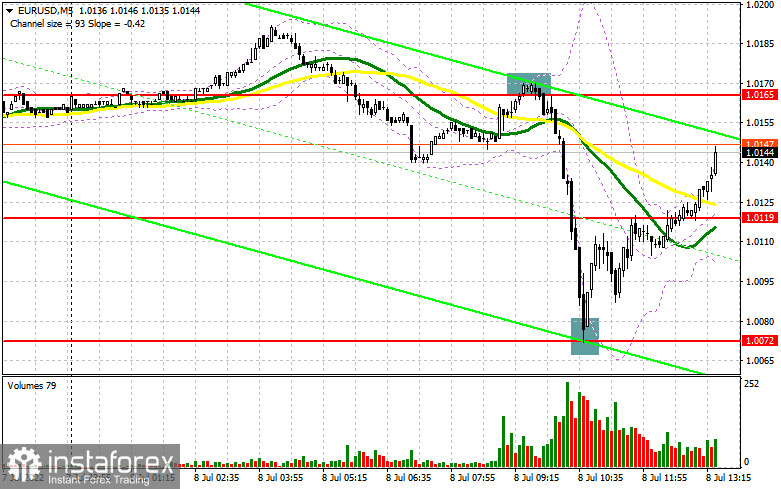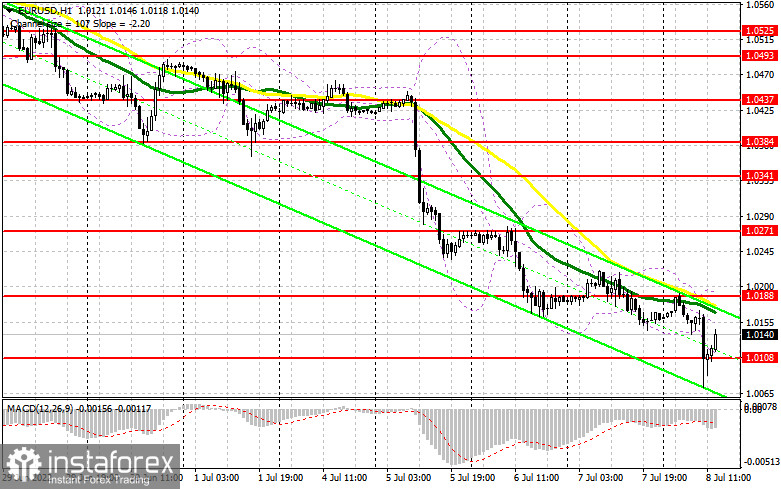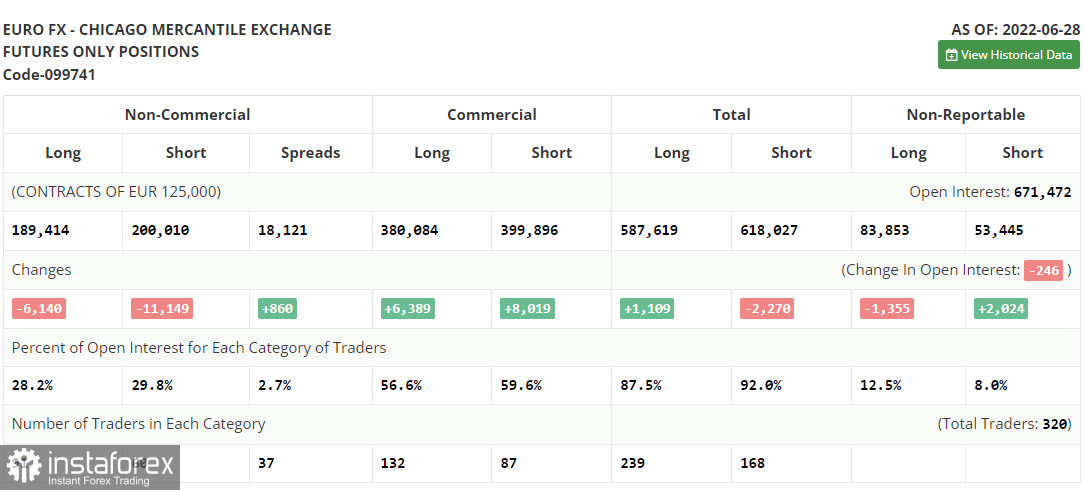In the morning article, I highlighted the levels of 1.0165 and 1.0072 and recommended making decisions with this level in focus. Now let's look at the 5-minute chart and try to figure out what actually happened. A small rise and a false breakout of 1.0165 at the beginning of the European session gave an excellent sell signal. The price dropped by 90 pips. At 1.0072, where I also advised opening long positions on the euro, another entry point appeared. At the time of writing the article, it gave more than 60 pips of profit.

What is needed to open long positions on EUR/USD
In the American session, the US is set to release a batch of macro stats on the labor market. It may stir up market activity. However, judging by the currency movements, volatility is already rising. For this reason, I had to completely revise the technical outlook as all the target levels were broken. Recent statements by Fed policymakers that they backed a July increase in the interest rate by another 0.75% triggered a decline in the euro. Sellers took notice of it and began to lock in profits even before the release of the Nonfarm Payrolls report. This report is the main highlight of the day. Traders are also anticipating data on the unemployment rate, which is expected to remain unchanged. At the same time, a sharp decline in NFP data may drag the US dollar down. If the report is upbeat, the euro will face short-term bearish pressure. In this case, it is likely to slide to the nearest support level of 1.0108, formed in the first half of the day. Only after a false breakout of this level, we can count on a buy signal. If so, the euro/dollar pair could grow to 1.0188 amid the upward correction. At this level, the moving averages are passing in the bearish territory. Only after a breakout and a downward test of 1.0108, there might be a new buy signal. If this scenario comes true, it will erase the bears' stop-loss orders, pushing the pair to the resistance level of 1.0271. The 1.0341 level will be a more distant target. Currently, there are no drivers for such strong growth. If EUR/USD decreases lower and bulls show no activity at 1.0108 after the publication of the NFP report, bulls may lose the upper hand. In this case, it is better to stay away from the market. It is recommended to open long positions only after a false breakout of the support level of 1.0033. You can buy EUR/USD immediately at a bounce from the 0.9994 level or even a lower of 0.9958, keeping in mind an upward intraday correction of 30-35 pips.
What is needed to open short positions on EUR/USD
The bears managed to defeat EUR bulls at the end of the week. They began to close positions very quickly, which was confirmed by the technical signals. If the euro rises during the US session after weak NFP data, only a false breakout of 1.0188, like the one that occurred in the first half of the day, will give an excellent sell signal. If so, the price may slip to the nearest support level of 1.0108. A breakout and a decline below this level, as well as an upward test, may generate an additional sell signal. It will also lead to a sharp drop in buyers' stop-loss orders, pushing the price down to a yearly low of 1.0033. Bears and bulls will fight fiercely for this level. If the price tumbles below, the likelihood of parity with the US dollar will significantly increase. As a result, it could depreciate to 0.9994, which is a very gloomy prospect. I recommend locking in profits at this level. A more distant target will be the 0.9958 level. If EUR/USD advances during the American session and bears show no energy at 1.0188, it will hardly affect the bearish momentum. In this case, it is better to cancel short positions until the test of 1.0271. A false breakout of this level will only strengthen the bearish trend. It will lead to the formation of the upper boundary of the medium-term downward channel. You can sell EUR/USD immediately at a bounce from a high of 1.0341 or even a high of 1.0384, keeping in mind a downward intraday correction of 30-35 pips.

COT
The COT report (Commitment of Traders) for June 28 again logged a drop in both long and short positions but it did lead to an increase in the negative delta. The number of short positions was lower than long ones. Last week, ECB President Christine Lagarde and Fed Chairman Jerome Powell made speeches. They stressed the need to tighten monetary policy to combat the highest inflation on record. This month, the ECB intends to start raising interest rates which should limit the upward potential of the US dollar against the euro. Eurozone inflation data released last week showed the regulator that they should urgently hike the key rate. However, given the headwinds in the global economy, demand for safe-haven assets is buoyant. Analysts are betting on the parity in the EUR/USD pair. The COT report revealed that the number of long non-commercial positions decreased by 6,140, to the level of 189,414, while the number of short non-commercial positions tumbled by 11,149 to the level of 200,010. The US dollar approaches new highs amid the low exchange rate of the euro, the need for further aggressive tightening by major central banks, and the recession in many developed countries. At the end of the week, the total non-commercial net position remained negative and amounted to -10,596 against -15,605. The weekly closing price dropped to 1.0584 against 1.0598.

Signals of technical indicators
Moving averages
EUR/USD is trading below 30- and 50-period moving averages. It means that the euro continues to decrease.
Remark. The author is analyzing the period and prices of moving averages on the 1-hour chart. So, it differs from the common definition of classic daily moving averages on the daily chart.
Bollinger Bands
In case of a rise, the upper limit of 1.0190 will act as resistance.
Definitions of technical indicators
- Moving average recognizes an ongoing trend through leveling out volatility and market noise. A 50-period moving average is plotted yellow on the chart.
- Moving average identifies an ongoing trend through leveling out volatility and market noise. A 30-period moving average is displayed as the green line.
- MACD indicator represents a relationship between two moving averages that is a ratio of Moving Average Convergence/Divergence. The MACD is calculated by subtracting the 26-period Exponential Moving Average (EMA) from the 12-period EMA. A 9-day EMA of the MACD called the "signal line".
- Bollinger Bands is a momentum indicator. The upper and lower bands are typically 2 standard deviations +/- from a 20-day simple moving average.
- Non-commercial traders - speculators such as retail traders, hedge funds and large institutions who use the futures market for speculative purposes and meet certain requirements.
- Non-commercial long positions represent the total long open position of non-commercial traders.
- Non-commercial short positions represent the total short open position of non-commercial traders.
- The overall non-commercial net position balance is the difference between short and long positions of non-commercial traders.
 English
English 
 Русский
Русский Bahasa Indonesia
Bahasa Indonesia Bahasa Malay
Bahasa Malay ไทย
ไทย Español
Español Deutsch
Deutsch Български
Български Français
Français Tiếng Việt
Tiếng Việt 中文
中文 বাংলা
বাংলা हिन्दी
हिन्दी Čeština
Čeština Українська
Українська Română
Română

